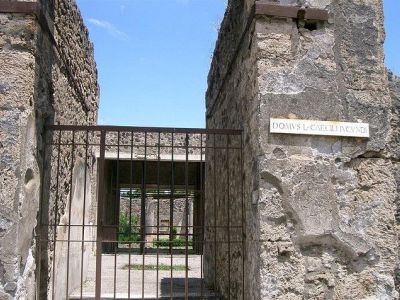House of Caecilius Iucundus, Pompei
The House of Caecilius Iucundus in Pompeii offers a glimpse into the life of a Roman banker (argentarius) and the broader societal context of ancient Pompeii. Iucundus was not just any banker; he specialized as a middleman at auctions, a role that was crucial in the economic fabric of the Roman world. Located on Stabiae Street, part of his residence still stands as a testament to his life and times, revealing details not only about Iucundus himself but also about Pompeian society and culture.
Among the notable discoveries within the house are wax tablets that shed light on the financial and personal dealings of Iucundus. These artifacts are invaluable for understanding the economic mechanisms and daily transactions in Pompeii. Additionally, a lararium, or household shrine, was found, emphasizing the spiritual and religious practices that were an integral part of Roman domestic life. Such shrines were common in Roman homes, serving as a space for worshiping household gods and ancestors, reflecting the deeply religious nature of Roman society.
A particularly striking feature of the house is a relief depicting the Temple of Jupiter during the devastating earthquake of 62 AD. This piece not only serves as an artistic representation but also as a historical record, providing insights into the impact of natural disasters on Pompeian society and the resilience of its people in rebuilding their lives and city.
The atrium, a focal point of the house, displayed paintings, indicating its role for hosting guests and business affairs, reflecting the owner's wealth and status. The floor boasts an elaborate black-and-white mosaic, typical in Roman homes, showcasing the owner's affluence and artistic preferences. At the entrance, a reclining dog mosaic serves as both a welcoming gesture and a deterrent, embodying the household's protective spirit.
The tablinum, or study, of Iucundus’s house, is adorned with beautiful wall paintings and contains an amphora given to the house owner by one of his sons, symbolizing familial affection and the importance of family ties in Roman society.
Among the notable discoveries within the house are wax tablets that shed light on the financial and personal dealings of Iucundus. These artifacts are invaluable for understanding the economic mechanisms and daily transactions in Pompeii. Additionally, a lararium, or household shrine, was found, emphasizing the spiritual and religious practices that were an integral part of Roman domestic life. Such shrines were common in Roman homes, serving as a space for worshiping household gods and ancestors, reflecting the deeply religious nature of Roman society.
A particularly striking feature of the house is a relief depicting the Temple of Jupiter during the devastating earthquake of 62 AD. This piece not only serves as an artistic representation but also as a historical record, providing insights into the impact of natural disasters on Pompeian society and the resilience of its people in rebuilding their lives and city.
The atrium, a focal point of the house, displayed paintings, indicating its role for hosting guests and business affairs, reflecting the owner's wealth and status. The floor boasts an elaborate black-and-white mosaic, typical in Roman homes, showcasing the owner's affluence and artistic preferences. At the entrance, a reclining dog mosaic serves as both a welcoming gesture and a deterrent, embodying the household's protective spirit.
The tablinum, or study, of Iucundus’s house, is adorned with beautiful wall paintings and contains an amphora given to the house owner by one of his sons, symbolizing familial affection and the importance of family ties in Roman society.
Want to visit this sight? Check out these Self-Guided Walking Tours in Pompei. Alternatively, you can download the mobile app "GPSmyCity: Walks in 1K+ Cities" from Apple App Store or Google Play Store. The app turns your mobile device to a personal tour guide and it works offline, so no data plan is needed when traveling abroad.
House of Caecilius Iucundus on Map
Sight Name: House of Caecilius Iucundus
Sight Location: Pompei, Italy (See walking tours in Pompei)
Sight Type: Attraction/Landmark
Sight Location: Pompei, Italy (See walking tours in Pompei)
Sight Type: Attraction/Landmark
Walking Tours in Pompei, Italy
Create Your Own Walk in Pompei
Creating your own self-guided walk in Pompei is easy and fun. Choose the city attractions that you want to see and a walk route map will be created just for you. You can even set your hotel as the start point of the walk.
Pompeii Introduction Walk II
Frozen at the moment it was buried under the thick blanket of ash and pumice, the city of Pompeii (now excavated) remains a unique window into the past, offering a snapshot of everyday life back in the 1st century AD Roman Empire. Aside from causing quick and unexpected death to the city, the huge eruption of Vesuvius in 79 AD did have one positive outcome – it preserved everything (properties,... view more
Tour Duration: 3 Hour(s)
Travel Distance: 2.3 Km or 1.4 Miles
Tour Duration: 3 Hour(s)
Travel Distance: 2.3 Km or 1.4 Miles
Pompeii Introduction Walk I
Modern-day Pompei is best known for its ancient predecessor, the Roman city of Pompeii, that fell victim to the massive eruption of Mount Vesuvius in 79 AD. The ruins of Pompeii, first uncovered in the late 18th century, were declared a World Heritage Site by UNESCO in 1997. Presently, this is one of the most popular tourist attractions in Italy, drawing annually up to 2.5 million visitors.
The... view more
Tour Duration: 2 Hour(s)
Travel Distance: 2.0 Km or 1.2 Miles
The... view more
Tour Duration: 2 Hour(s)
Travel Distance: 2.0 Km or 1.2 Miles





